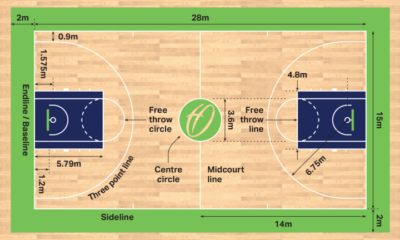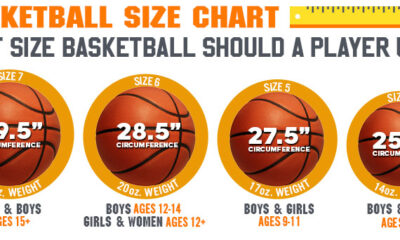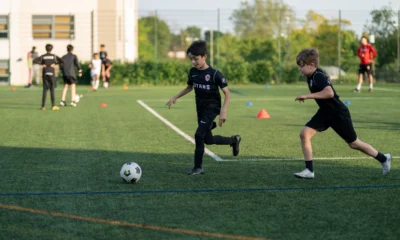Sports
Mastering the Drawing: A Step-by-Step Guide to Basketball
Published
9 months agoon
By
Admin
basketball
Basketball is not only a thrilling sport but also an excellent subject for artists seeking to hone their drawing skills. Whether you want to capture the essence of a player dribbling down the court, the intensity of a slam dunk, or the geometry of a basketball itself, learning how to draw basketball scenes can be a fun and rewarding experience. This guide will provide a comprehensive step-by-step approach to mastering basketball drawing techniques, including important tips, tricks, and insights to make your work stand out.
1. Understanding the Fundamentals of Drawing Basketball
Before diving into complex scenes or action shots, it is essential to start with the basics. The basketball itself is a relatively simple object to begin with due to its spherical shape, but mastering it requires understanding light, shadow, and proportions.
Key Concepts:
- Spheres and Curves: A basketball is a sphere, which means it has no hard edges, only curves. Getting the round shape right is crucial.
- Texture: Basketballs typically have a textured surface with small indentations. You don’t need to draw each one individually, but using shading and highlighting techniques can mimic the texture effectively.
- Lines and Panels: The basketball is divided into sections by black curved lines. These lines must be accurately placed and curved to maintain the ball’s round appearance.
Step-by-Step:
- Start by drawing a circle using a light pencil stroke.
- Lightly shade the edges of the circle to give it a sense of roundness. The light source should dictate where the shadows fall.
- Draw the distinctive black lines that divide the basketball into panels. These lines should follow the contours of the sphere, curving accordingly.
- Add texture by using stippling or soft shading techniques to mimic the ball’s bumpy surface.
2. Sketching a Basketball Player
Once you have the basketball itself down, the next step is drawing a player holding, dribbling, or shooting the ball. This requires understanding human anatomy, especially in motion, and how to depict dynamic poses.
Key Concepts:
- Proportions: Pay close attention to body proportions. Athletes have well-defined muscles and are often drawn in action, so the limbs will likely be extended, and the muscles will be tensed.
- Motion and Dynamics: Basketball is a fast-paced sport, so capturing motion in your drawing is crucial. Whether it’s a player leaping for a dunk or moving swiftly across the court, the sense of energy should be clear.
- Perspective: Depending on the angle, perspective can dramatically change how the figure looks. For instance, a player jumping toward the viewer might have an exaggerated arm length.
Step-by-Step:
- Begin with a basic skeleton or stick figure to map out the player’s pose.
- Flesh out the body with simple shapes—ovals for limbs, circles for joints, and rectangles for the torso.
- Pay special attention to the proportions and balance of the figure. The legs and arms should align naturally with the body.
- Once the body is sketched, add details such as the uniform, facial features, and shoes.
- If the player is interacting with the basketball, ensure that the hands are correctly positioned around the ball, paying attention to the fingers’ curvature.
- To enhance the feeling of motion, use strong lines and flowing shapes to indicate movement.
3. Drawing Action Shots: Slam Dunks, Dribbles, and Shooting
The next step is mastering action shots, such as a player dunking or shooting the ball. This requires not only a solid grasp of anatomy and motion but also an understanding of the key moments within the action.
Slam Dunk:
- Focus on the player’s height and outstretched arms.
- Exaggerate the body’s movement to give a sense of energy and impact.
- The ball should be above the rim, with the net slightly bent from the force.
Dribbling:
- The player’s hand should be lightly touching the ball, which should appear slightly flattened as it makes contact with the floor.
- The player’s body is often hunched forward, indicating speed and agility.
Shooting:
- The ball should be just leaving the player’s fingertips, with the body positioned in a perfect form—knees slightly bent, arms outstretched, and eyes focused on the hoop.
4. Adding Detail and Refining the Drawing
After you have sketched out the basic form, it’s time to add the finer details that bring your basketball drawing to life.
Key Concepts:
- Shading and Highlighting: To give the basketball and players a sense of realism, use shading to depict the direction of light and the depth of objects. Highlight areas where the light hits directly, such as the top of the basketball or the player’s face if lit from above.
- Textures and Patterns: For the basketball, use subtle shading techniques to suggest its rough texture. For the player’s uniform, add folds in the fabric and logos that reflect the team’s branding.
- Background Elements: Including the court, crowd, or even a scoreboard can add context to your drawing. These elements should not overshadow the main action but complement it.
Step-by-Step:
- Refine the outline of the player and the basketball, making sure the lines are clean and crisp.
- Add shading to create depth. Areas further from the light source should be darker, while those closer to the light should remain brighter.
- Add texture to the basketball and the player’s uniform using cross-hatching or stippling techniques.
- If drawing a court or background, use lighter lines and less detail to keep the focus on the main subject.
- Finish with highlights to emphasize the areas where light reflects, giving your drawing a three-dimensional feel.
5. Tips for Mastering Basketball Drawing
- Practice Motion: Basketball involves constant movement, so practice drawing players in different positions to capture a sense of fluidity and action.
- Use References: Look at basketball photography or watch games to observe how players move, handle the ball, and interact with their environment.
- Focus on Expression: Capturing the intensity and emotion of the players, whether it’s the strain of a dunk or the focus of a shot, can add a dynamic element to your artwork.
- Experiment with Perspective: Try different angles for your drawings, such as a view from above the court or a close-up of a player’s face as they prepare to shoot.
6. Conclusion
Mastering basketball drawing takes practice, patience, and a keen eye for detail. By starting with the fundamentals and gradually moving into more complex scenes and actions, you can build a solid foundation. Remember to focus on anatomy, motion, and perspective to bring your basketball artwork to life. Keep practicing and experimenting with different styles and techniques, and soon you’ll be creating dynamic basketball drawings that captivate your audience.


Clipart: T4H-X66PIH4= Turkey: Creative Uses & Benefits

Key Software Systems: Leading Innovation in Courier Delivery Management

Refrigerated Trailers Benefits and Uses

Jessica Dorrell: A Comprehensive Overview

minecraft (2009) game icons banners

Everything You Need to Know About 24 Hour Fitness Membership Plans and Costs

wallpaper:znvmimg_hwe= stitch

drawing:_k5ftwawefm= pinterest

How Much Does Golden Corral Cost for Adults? Understanding Golden Corral Adult Prices

Understanding IP Gacor: A Comprehensive Overview

Welcome to Simp City Forum!

Best Website For Overseas Soccer Relay

What Skateboarding Does To Your Body

Stages of Registration of a Company As An LLC

Navigating the World of News: A Guide

The Allure and Significance of Lavender Farms

Mastering the Drawing: A Step-by-Step Guide to Basketball

Exploring newbie blogs: A deep dive into the world of networking insights

How to Sign In to Kahoot: A Comprehensive Guide

Discover the Journalism Excellence of the Jerusalem Post

Clipart: T4H-X66PIH4= Turkey: Creative Uses & Benefits

Key Software Systems: Leading Innovation in Courier Delivery Management

Refrigerated Trailers Benefits and Uses

Jessica Dorrell: A Comprehensive Overview

minecraft (2009) game icons banners

Everything You Need to Know About 24 Hour Fitness Membership Plans and Costs

wallpaper:znvmimg_hwe= stitch

drawing:_k5ftwawefm= pinterest

How Much Does Golden Corral Cost for Adults? Understanding Golden Corral Adult Prices













